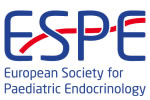hrp0086p1-p362 | Gonads & DSD P1 | ESPE2016
Aromatase Activity is Disrupted by Mutations in P450 Oxidoreductase
Udhane Sameer S. , Parween Shaheena , Pandey Amit V.
hrp0084fc10.4 | Perinatal Endocrinology | ESPE2015
Effect of P450 Oxidoreductase Variants on Metabolism by Cytochrome P450 Proteins
Parween Shaheena , Udhane Sameer S , Pandey Amit V
hrp0084p2-457 | Growth | ESPE2015
Low Plasma Ghrelin Levels in Children with Severe Protein Energy Malnutrition
Harikrishnan V , Kumar Rakesh , Sachdeva Naresh , Dayal Devi
hrp0084p3-1235 | Turner | ESPE2015
Turner Syndrome in Iceland 1968–2012: Congenital Anomalies and Clinical Outcomes
Sigmarsdottir Arndis A , Johannsson Johann H , Sigurjonsdottir Helga A , Thorsson Arni V
hrp0094p2-317 | Growth and syndromes (to include Turner syndrome) | ESPE2021
Noonan syndrome patients with short stature at a single pediatric endocrinology centre
Deyanova Y. , Iotova V. , Tsochev K. , Stoyanova M. , Stoicheva R. , Mladenov V. , Bazdarska Y. , Galcheva S. , Zenker M. ,
hrp0089p3-p214 | GH & IGFs P3 | ESPE2018
Two Siblings with Short Stature
V Sri Nagesh , Dauber Andrew , Kanithi Ravishankar , Dutta Deep , G Ram Kumar
hrp0089p1-p214 | Sex Differentiation, Gonads and Gynaecology or Sex Endocrinology P1 | ESPE2018
In Silico and In vitro Studies of Human SRD5A2 Variants in Search for Activating Variants Explaining Androgen Excess Reveal Additional Loss of Function Variants
Katharopoulos Efstathios , Sauter Kay-Sara , Pandey Amit V , Fluck Christa E
hrp0086rfc4.2 | Pathophysiology of Obesity | ESPE2016
Adipocytokines Delay Pubertal Maturation of Human Sertoli Cells
Wagner Isabel V. , Yango Pamela , Svechnikov Konstantin , Tran Nan D. , Soder Olle
hrp0086rfc4.6 | Pathophysiology of Obesity | ESPE2016
Adipose Tissue – A Source of Hyperandrogenism in Obese Females?
Wagner Isabel V. , Sahlin Lena , Savchuk Iuliia , Svechnikov Konstantin , Soder Olle
hrp0082p1-d3-51 | Bone (1) | ESPE2014
Bone Geometry, Volumetric Density, Microarchitecture and Estimated Bone Strength Assessed by HR-pQCT in Adult Patients with Hypophosphatemic Rickets
Shanbhogue Vikram v. , Hansen Stinus , Folkestad Lars , Brixen Kim , Beck-Nielsen Signe Sparre



